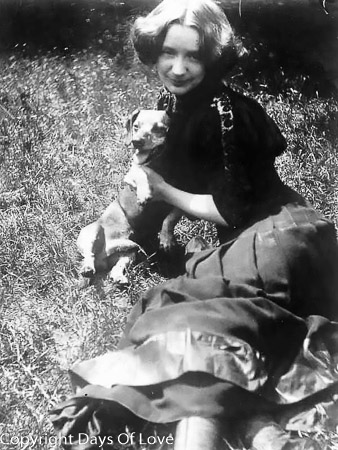

Husband Lili Elbe
Queer Places:
Royal Danish Academy of Fine Arts, Kongens Nytorv 1, 1050 København K, Danimarca
Solbjerg Kirkegård, Roskildevej 54, 2000 Frederiksberg, Danimarca
 Gerda Marie Fredrikke Wegener (née Gottlieb; 15 March 1886 – 28 July
1940) was a Danish illustrator and painter. Her artwork largely contains
images of fashionable women in the style of art nouveau and later art deco.
ublishing in Paris during the first half od the 20th century, women
illustrators such as Gerda Wegener, Clara
Tice, Mariette Lydis,
Margit Gaal, and
Suzanne Ballivet produced
sexual graphics of women making love.
Gerda Marie Fredrikke Wegener (née Gottlieb; 15 March 1886 – 28 July
1940) was a Danish illustrator and painter. Her artwork largely contains
images of fashionable women in the style of art nouveau and later art deco.
ublishing in Paris during the first half od the 20th century, women
illustrators such as Gerda Wegener, Clara
Tice, Mariette Lydis,
Margit Gaal, and
Suzanne Ballivet produced
sexual graphics of women making love.
Gottlieb grew up in the provinces, in the village of Hammelev near the city of Grenaa, the daughter of Justine (née Østerberg) and Emil Gottlieb, a vicar in the Lutheran church. Her father had Huguenot ancestry and her family was conservative. She had three siblings but was the only child to live to adulthood. She showed artistic talent at a young age and began training. Her family moved to Hobro and later she moved to Copenhagen to pursue her education at the Royal Danish Academy of Fine Arts.
Her career as an artist began after graduating from the Academy in 1907 and 1908 when she won a drawing contest put on by the Politiken newspaper. She then was the center of a controversy called the Peasant Painter Dispute after one of her works, a portrait of Ellen von Kohl, was rejected for exhibitions due to the style of the piece.[1]
She was inspired by fashion, and sought work as an illustrator for Vogue, La Vie Parisienne and other magazines. She became a well-known artist in Paris, but was less successful in Denmark, where people found her work controversial. She held exhibitions of her work at popular art studios around Europe. In 1925, she won a prize for her artwork in competition at the 1925 World Fair in Paris.[2] She was known for her illustrations created for advertisements and was also a sought-after portrait painter. She befriended Ulla Poulsen (1905-2001), a famous Danish ballerina, who became a frequent model for her paintings. She and her spouse were also close friends with artist Rudolph Tegner and his wife Elna.
She met fellow artist Lili Elbe (then known as Einar Wegener, and identified as male) at art school.[3] They married in 1904, when she was 18 and her spouse was 22.[4] They traveled through Italy and France, eventually settling in Paris in 1912. The couple immersed themselves in the Bohemian lifestyle of the time, befriending many artists, dancers and other figures from the artistic world, often attending carnivals and other public festivals.

Lili Elbe (?) c.1928
Gerda Wegener (1885–1940) (attributed to)
Wellcome Collection
At the time, many considered Lili Elbe to be the more talented artist, but she toned down her own work and profile to help her wife in her artistic endeavors. During this time Elbe began to wear female clothing, and adopted her female name and persona,[5] becoming Gerda Wegener's favorite model, in paintings of beautiful women with haunting almond-shaped eyes dressed in chic fashions. In 1913, the art world was shocked when they learned that the model who had inspired her depictions of petite femmes fatales was in fact her spouse.[4]
As Elbe adopted her female identity, Gerda Wegener commonly introduced her as Einar Wegener's cousin when she was dressed in female attire.[6] In 1930 Elbe underwent sex reassignment surgery (the second known). As Danish law at the time did not recognize marriage between two women, their marriage was annulled in October 1930 by King Christian X. Elbe died in 1931 from complications of the surgery.
In 1931, devastated by Elbe's death, Wegener married Italian officer, aviator, and diplomat Major Fernando Porta, who was ten years her junior, and moved with him to Morocco (specifically Marrakech and Casablanca). She continued to create art during this period, signing her paintings as "Gerda Wegener Porta". She divorced Porta in 1936 after a rocky marriage, with him swindling her funds, and returned to Denmark in 1938. She held her last exhibition in 1939, but by this time, her artwork was out of style. She had no children, and lived alone in relative obscurity, and began to drink heavily. She kept an income by selling hand-painted postcards.
She died on July 28, 1940, in Frederiksberg, Denmark, shortly after Nazi Germany invaded the country.[7] Her small estate was auctioned off, and there was only a small obituary printed in the local paper. Some reports claim she married Einar Wegener because they were both homosexuals, and they knew that in order to find work at that time, they needed to keep this a secret.
My published books:
https://en.wikipedia.org/wiki/Gerda_Wegener